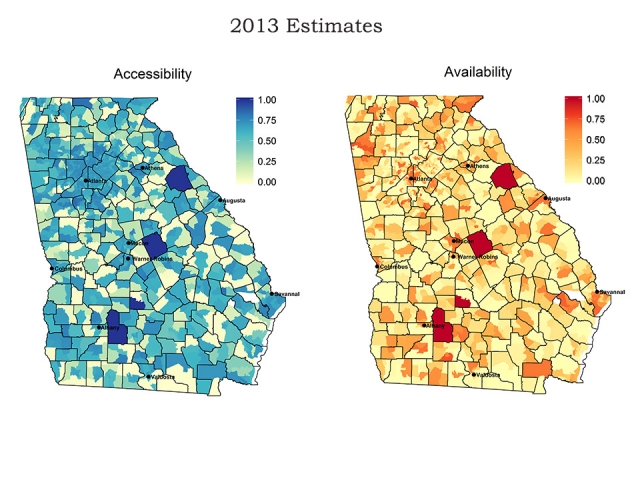
Data descriptor citation:
Harati, P., Gentili, M., Serban, N. "Accessibility and Availability of Adult Primary Care: Georgia", published by the Health Analytics Group @ GT.
This data descriptor provides spatial access estimates for adult primary care in the state of Georgia in 2013 at the census tract level. Adult primary care consists of visits to general practice, family medicine, and internal medicine physicians, nurse practitioners, and physician assistants by the population age 19-64. Estimates are included for both the overall adult population (that is, Medicaid-insured, privately-insured and uninsured populations combined) and for the Medicaid-insured population alone. Spatial access measures considered are Accessibility, Availability, and Coverage.
Accessibility is a measure between 0 and 1 reflecting the distance barriers patients face to reach their providers. It is calculated as one minus the ratio between the average distance a person travels to reach his/her assigned provider and the maximum allowed distance according to the guidelines established by the U.S. Department of Health and Human Services. Higher values mean on average, patients living in that geographic area do not have to travel as far to access care.
Availability is a measure between 0 and 1 reflecting the opportunity patients have to choose among different providers. It is calculated as one minus the congestion (the ratio between assigned visits to a provider and his/her maximum caseload) a person experiences for each visit at his/her assigned provider. Higher values mean on average, patients living in that geographic area visit providers who have more excess capacity.
Coverage is a measure between 0 and 1 reflecting patients’ ability to find providers to serve them. Specifically, it equals the proportion of adults in a geographic area who were matched with a provider.
Also included in the file is the estimated number of visits needed and the estimated number of visits served. The number of visits needed depends on the age, gender, and insurance status of the population. The number of visits served is the number of visits needed that providers are able to see, which is based on the estimated supply of providers. The difference between needed and served visits is the unmet need for the population residing in that geographic area.
These estimates can be used to identify locations where to target improvements in spatial access to adult primary care and to quantify disparities between Medicaid-insured v. non Medicaid-insured adult population.
The data file attached with this descriptor includes the following columns:
GEOID10 - The identification number of the census tract
X & Y - latitude and longitude
Accessibility: Accessibility for the overall population living in that census tract
AccessibilityMED: Accessibility for the Medicaid-insured population living in that census tract
Availability: Availability for the overall population living in that census tract
AvailabilityMED: Availability for the Medicaid-insured population living in that census tract
Coverage: Coverage for the overall population living in that census tract
CoverageMED: Coverage for the Medicaid-insured population living in that census tract
VisitsNeeded: The number of visits needed by the overall population living in that census tract
VisitsServed: The number of visits needed by the overall population living in that census tract that are able to be served by the available supply
VisitsNeededMED: The number of visits needed by the Medicaid-insured population living in that census tract
VisitsServedMED: The number of visits needed by the Medicaid-insured population living in that census tract that are able to be served by the available supply
- Estimates
- Access
Harati, P., Gentili, M., Serban, N. (2015) "Projecting the Impact of the Affordable Care Act Provisions on Accessibility and Availability of Primary Care for the Adult Population in Georgia", under review.
